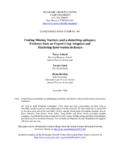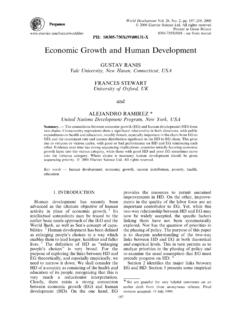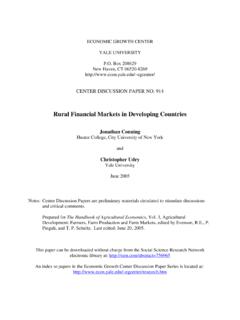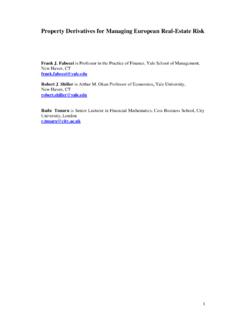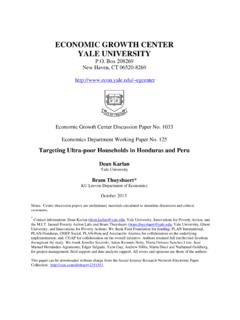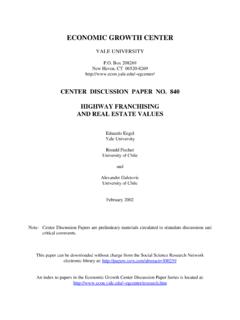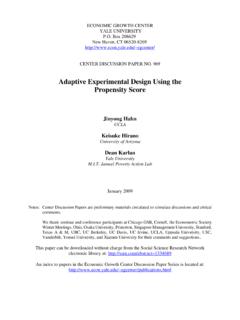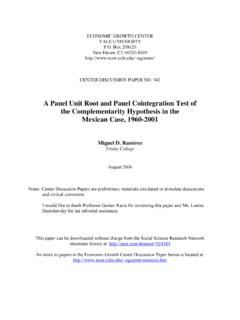Transcription of Quality Minus Junk - Yale University
1 Quality Minus junk Clifford S. Asness, Andrea Frazzini, and Lasse H. Pedersen* This draft: October 9, 2013 Abstract We define a Quality security as one that has characteristics that, all-else-equal, an investor should be willing to pay a higher price for: stocks that are safe, profitable, growing, and well managed. High- Quality stocks do have higher prices on average, but not by a very large margin. Perhaps because of this puzzlingly modest impact of Quality on price, high- Quality stocks have high risk-adjusted returns. Indeed, a Quality - Minus - junk (QMJ) factor that goes long high- Quality stocks and shorts low- Quality stocks earns significant risk-adjusted returns in the and globally across 24 countries. The price of Quality , how much investors pay extra for higher Quality stocks varies over time, reaching a low during the internet bubble.
2 Further, a low price of Quality predicts a high future return of QMJ. Finally, controlling for Quality resurrects the otherwise moribund size effect. * Andrea Frazzini is at AQR Capital Management, Two Greenwich Plaza, Greenwich, CT 06830, e-mail: web: ~af227/. Cliff Asness is at AQR Capital Management, Two Greenwich Plaza, Greenwich, CT 06830. Lasse H. Pedersen is at New York University , Copenhagen Business School, AQR Capital Management, CEPR and NBER, 44 West Fourth Street, NY 10012-1126; e-mail: web: ~lpederse/. We thank Antti Ilmanen, Ronen Israel, Johnny Kang, John Liew, Toby Moskowitz, Per Olsson, and Scott Richardson for helpful comments and discussions as well as participants in the SIFR Institute of Financial Research Conference on Re-Thinking Beta.
3 Quality Minus junk - Asness, Frazzini, and Pedersen - Page 2 When did our field stop being asset pricing and become asset expected returning? .. Market-to-book ratios should be our left-hand variable, the thing we are trying to explain, not a sorting characteristic for expected returns. Cochrane, Presidential Address, American Finance Association, 2011 The asset pricing literature in financial economics studies the drivers of returns, but, while linked, the economic consequences of market efficiency ultimately depend on prices, not returns, as emphasized by Summers (1986) and Cochrane (2011). Do the highest Quality firms command the highest price so that these firms can finance their operations and invest? To address this question, we define Quality as characteristics that investors should be willing to pay a higher price for, everything else equal.
4 We show that Quality is priced, that is, investors pay more for firms with higher Quality characteristics. However, the explanatory power of Quality for prices is limited, presenting a puzzle for asset pricing. This puzzle for asset prices is analogous to the famous puzzle of the low R2 of asset returns presented by Roll (1984, 1988). Consistent with the limited pricing of Quality , high- Quality stocks have historically delivered high risk-adjusted returns while low- Quality junk stocks delivered negative risk-adjusted returns. Hence, a Quality - Minus - junk (QMJ) portfolio that invests long Quality stocks and shorts junk stocks produces high risk-adjusted returns. Further, we find that the price of Quality (the marginal amount extra investors pay for higher Quality characteristics) has varied over time as the market has sometimes put a larger or smaller price premium on Quality stocks vs.
5 junk stocks. For instance, the price of Quality was particularly low during the internet bubble. Since prices and returns are linked, the price of Quality predicts the future return to the QMJ factor. Lastly, we show that QMJ has broader asset pricing implications, including resurrecting the size effect. To apply the general definition of Quality , we must identify stock characteristics that should command a higher price. Gordon s growth model presents a simple framework to get Quality Minus junk - Asness, Frazzini, and Pedersen - Page 3 intuition for the natural Quality characteristics. Indeed, rewriting Gordon s growth model, we can express a stock s price-to-book value (P/B) as follows:1 We scale prices by book values to make them more stationary over time and in the cross section.
6 The four right-hand side variables form the basis for our definition of Quality . These variables are intuitive and extend beyond the Gordon model in terms of their relevance for stock For each Quality characteristic, we consider several measures in order to have a robust analysis and ensure that the explanatory power of Quality on price (or the lack thereof) is not driven by a specific measurement choice: i. Profitability. Profitability is the profits per unit of book value. All else equal, more profitable companies should command a higher stock price. We measure profits in several ways, including gross profits, margins, earnings, accruals and cash flows, and focus on each stock s average rank across these metrics. ii. Growth.
7 Investors should also pay a higher price for stocks with growing profits. We measure growth as the prior five-year growth in each of our profitability measures. iii. Safety. Investors should also pay, all-else-equal, a higher price for a stock with a lower required return, that is, a safer stock. What should enter into required return is still a very contentious part of the literature. We do not attempt to resolve those issues here, rather we take a simple common sense approach. We consider both return-based measure of safety ( , market beta and volatility) and fundamental-based measures 1 We rewrite the Gordon model simply as . 2 Equation (1) is a special case of the general present-value relation.
8 We use the Gordon model to simplify notation but the same intuition applies to the general present-value relation. Quality Minus junk - Asness, Frazzini, and Pedersen - Page 4 of safety ( , stocks with low leverage, low volatility of profitability, and low credit risk). iv. Payout. The payout ratio is the fraction of profits paid out to shareholders. This characteristic is determined by management and can be seen as a measure of shareholder friendliness. Management s agency problems are diminished if free cash flows are reduced through higher dividends (Jensen (1986)). We also consider both net payout as well as issuance (dilution). Payout is an example of how each of these measures is about their marginal effect, all else being equal.
9 Indeed, if a higher payout is associated with a lower future profitability or growth, then this should not command a higher price, but a higher payout should be positive when we hold all other factors constant. For the market to rationally put a price on these Quality characteristics, they need to be measured in advance and predict future Quality characteristics, that is, they need to be persistent. We show that this is indeed the case; profitable, growing, safe, and high-payout stocks continue on average to display these characteristics over the following five or ten years. We test the pricing of Quality over a long sample of stocks from 1956 to 2012 and a broad sample of stocks from 24 developed markets from 1986 to 2012.
10 To evaluate the pricing of Quality , we first run cross-sectional regressions of price-to-book on each stock s overall Quality score. Both in the long and broad sample, we find that higher Quality is significantly associated with higher prices. However, the explanatory power of Quality on price is limited as the average R2 is only 12% in the long sample and 6% in the broad sample. When we also control for the firm s size and past 12-month stock returns, the cross-sectional R2 increases to, respectively, 31% and 26%, still leaving unexplained a large amount of the cross sectional distribution of prices. Interestingly, larger firms are more expensive controlling for Quality , the analogue of the size effect on returns (Banz (1981)).
